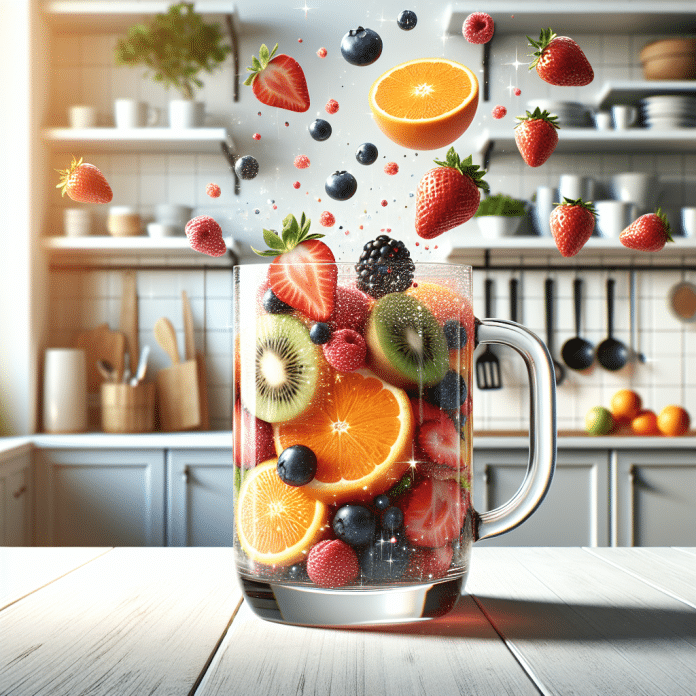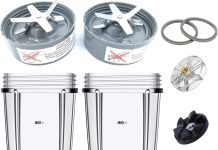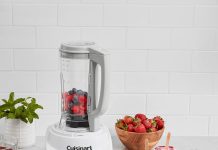You’re passionate about making fresh juice at home, but you’re wondering how to store it to ensure you retain all those nutritious vitamins and minerals. In this article, we’ll explore some practical tips on how to store fresh juice to maintain its maximum nutrients. From choosing the right containers to understanding optimal temperature and shelf life, we’ve got you covered. So, let’s dive in and learn how to keep your freshly made juice as healthy and nourishing as possible!
Review contents
Choosing the Right Storage Container
When it comes to storing fresh juice, choosing the right storage container is crucial in order to maintain the nutrients and quality of the juice. There are several options available, each with its own benefits and considerations.
Glass Containers
Glass containers are a popular choice for storing fresh juice due to their non-reactive nature. They do not leach any harmful chemicals into the juice, ensuring that its taste and nutritional value remain intact. Glass containers also provide an excellent barrier against light and oxygen, further preserving the quality of the juice. Additionally, glass containers can be easily cleaned and reused, making them a sustainable and environmentally-friendly option.
Stainless Steel Containers
Stainless steel containers are another reliable option for storing fresh juice. Similar to glass containers, stainless steel is non-reactive and does not alter the taste or quality of the juice. Furthermore, stainless steel containers are durable and resistant to corrosion, ensuring that the juice remains uncontaminated. These containers are also easy to clean and maintain, making them a convenient choice for long-term storage.
Food-grade Plastic Containers
Food-grade plastic containers can be a convenient and cost-effective option for storing fresh juice. However, it is essential to ensure that the plastic used is specifically labeled as food-grade, as this guarantees its safety and non-toxicity. Food-grade plastic containers are lightweight, easy to handle, and often come with airtight seals, which help in preserving the freshness of the juice. Nevertheless, it is important to note that plastic containers can be prone to leaching harmful chemicals such as BPA, which leads us to our next point.
Avoiding Containers with BPA
When selecting storage containers, it is important to avoid those that contain Bisphenol A (BPA). BPA is a chemical commonly found in some plastic containers and can seep into the juice, posing potential health risks. To mitigate this, opt for BPA-free containers, such as glass or stainless steel, which do not contain this harmful chemical. By avoiding containers with BPA, you can ensure the safety and quality of your stored juice.
Keeping Fresh Juice Refrigerated
Properly refrigerating fresh juice is essential in maintaining its freshness and preserving its nutrients. Here are some key considerations for keeping your fresh juice refrigerated.
Refrigeration Temperature
The temperature at which you store your fresh juice is crucial in maintaining its quality. Refrigerate your juice at a temperature between 32°F (0°C) and 41°F (5°C). This range ensures that the juice remains chilled enough to inhibit the growth of bacteria, while preventing it from freezing and compromising its taste and texture.
Proper Sealing
To prevent the juice from oxidizing and losing its nutrients, it is important to ensure proper sealing of the containers. Use airtight lids or caps on your storage containers to create a barrier against oxygen, which can degrade the quality of the juice over time.
Refrigerator Placement
The placement of your fresh juice containers within the refrigerator can also impact their longevity. Avoid storing the juice near the refrigerator door, as it is subject to fluctuating temperatures each time the door is opened. Instead, place the containers towards the back of the refrigerator, where the temperature remains more consistent.
Avoiding Exposure to Light
Light exposure can have a detrimental effect on the nutrients in fresh juice. To minimize this, store your juice containers in a dark area of the refrigerator, away from direct light. If using transparent containers, consider covering them with aluminum foil or storing them in opaque bags to shield the juice from light exposure.
Freezing Fresh Juice
Freezing fresh juice is an excellent way to extend its shelf life while retaining its nutritional value. Here are some important considerations when freezing your fresh juice.
Benefits of Freezing
Freezing fresh juice not only prolongs its freshness but also helps to retain its vitamins, minerals, and enzymes. By freezing the juice, you can enjoy its nutrients even after an extended period of time. Additionally, freezing can be a convenient way to preserve excess juice, allowing you to enjoy it at a later date without any compromise in quality.
Preparing Juice for Freezing
Before freezing fresh juice, ensure that it is properly strained to remove any pulp or solids. Pulp can lead to a change in texture and quality when frozen. Once strained, transfer the juice to suitable freezer-safe containers, leaving some headspace to account for expansion as the juice freezes.
Choosing the Right Freezer Container
When selecting freezer containers for your juice, opt for materials that are durable and provide good insulation. Glass containers, such as mason jars, or BPA-free plastic containers with tight-fitting lids are excellent choices for freezing fresh juice. Avoid using materials that are prone to cracking or allowing air to leak in, such as low-quality plastic or thin glass.
Proper Freezer Temperature
Maintaining the proper freezer temperature is crucial when freezing fresh juice. Set your freezer to a temperature of 0°F (-18°C) or below to ensure optimal preservation. Remember to allow some space between containers to promote efficient air circulation and avoid overcrowding.
Freezing Juice in Ice Cubes
Freezing juice in ice cube trays is a convenient method for portioning and utilizing the juice. Once frozen, transfer the juice cubes to a freezer bag, removing as much air as possible, and seal tightly. This method allows for easy access to small portions of juice, which can be added to smoothies or used as chilled refreshers.
Sealing and Vacuum Packing
Sealing and vacuum packing fresh juice can help to further extend its shelf life by removing excess air and oxygen from the storage containers. Here’s what you need to know about this preservation method.
Using Vacuum Sealing Machines
Vacuum sealing machines can be a valuable tool for preserving fresh juice. These machines work by removing the air from the storage container and creating an airtight seal that prevents any oxygen from coming into contact with the juice. By eliminating oxygen, the risk of oxidation and nutrient loss is significantly reduced, ensuring the juice remains fresh for a longer period.
Benefits of Vacuum Packing
Vacuum packing fresh juice offers numerous benefits. By sealing the juice containers and removing oxygen, you can prevent the growth of harmful bacteria and reduce the risk of spoilage. Additionally, vacuum packing helps to retain the natural flavors and aromas of the juice, enhancing your overall sensory experience.
Vacuum Packing Process
To vacuum pack fresh juice, begin by filling the chosen storage container with the juice, leaving some headspace for expansion. Place the container into the vacuum sealing machine and follow the manufacturer’s instructions to remove the air and seal the container. Once sealed, store the vacuum-packed juice in the refrigerator or freezer, depending on your needs.
Special Considerations for Vacuum Packing
It is important to note that not all juices are suitable for vacuum packing. Carbonated or effervescent juices and those containing high sugar or high acid content may not fare well in vacuum-sealed containers. Before vacuum packing, ensure that the juice is appropriate for this preservation method to avoid any potential risks or compromises in quality.
Using Preservatives
While the goal is to store fresh juice as naturally as possible, there are times when the use of preservatives may be necessary. Here’s what you need to know about using preservatives to maintain the quality and safety of your stored juice.
Why Use Preservatives
Preservatives are useful in inhibiting the growth of bacteria, yeast, and mold, which can cause spoilage or pose health risks. They help to extend the shelf life of the juice, enabling you to enjoy it for a longer duration. Preservatives can also help to maintain the flavor, color, and texture of the juice, ensuring that it remains as close to its freshly squeezed state as possible.
Natural Preservatives
If you prefer to use natural preservatives, there are several options available. Citric acid, ascorbic acid (vitamin C), and certain essential oils, such as lemon or grapefruit, possess antimicrobial properties and can be effective in extending the shelf life of fresh juice. However, it is important to use these natural preservatives in the correct dosage to avoid altering the flavor or texture of the juice.
Commercial Preservative Options
For those who prefer convenience, commercial preservatives are readily available in the market. These preservatives are specifically formulated to inhibit microbial growth and are often designed for use in fruit juices. When opting for commercial preservatives, carefully read and follow the instructions and recommended dosage for proper usage.
Proper Usage and Dosage
Whether using natural or commercial preservatives, it is crucial to follow the recommended usage and dosage guidelines. Adding too much preservative can lead to an unpleasant taste and potentially harmful effects. When using a preservative, be sure to thoroughly mix it into the juice to ensure even distribution and effective preservation.
Avoiding Air and Oxygen Exposure
Air and oxygen exposure can greatly impact the nutritional quality of fresh juice. To minimize nutrient loss and maintain the freshness of your stored juice, it is important to take the following measures.
Air and Oxygen’s Impact on Nutrients
Exposure to air and oxygen can lead to oxidation, causing the degradation of nutrients in fresh juice. Oxygen-sensitive vitamins, such as vitamin C, are particularly susceptible to this process, resulting in a decrease in their nutritional value over time. By minimizing air and oxygen exposure, you can preserve the integrity of these essential nutrients.
Filling Containers Properly
When filling storage containers with fresh juice, it is important to leave minimal headspace to minimize the amount of air in the container. This ensures that the juice makes maximum contact with the container, reducing the surface area exposed to oxygen. Avoid overfilling the containers, as this can lead to leakage and potential spoilage.
Choosing Containers with Airtight Seals
Select storage containers that come with airtight seals, such as screw-on lids or snap-on caps. These seals create an effective barrier against air and oxygen, preventing their entry into the container. Additionally, ensure that the seals are in good condition and fit tightly to maintain their efficacy.
Removing Air from Storage Containers
If storing your fresh juice in containers with larger headspace, consider removing as much air as possible before sealing. One method is to use a vacuum pump or manually press the container to eliminate excess air. This extra step can help limit oxygen exposure and prolong the freshness of the juice.
Factors Affecting Nutrient Loss
Several factors contribute to nutrient loss in stored fresh juice. Understanding these factors can help you take appropriate measures to minimize nutrient degradation and maintain the nutritional value of your juice.
Light Exposure
Exposure to light, especially sunlight, can lead to the degradation of certain nutrients in fresh juice. The UV rays present in sunlight can break down vitamins and other sensitive compounds, resulting in a loss of nutritional value. Therefore, it is important to store your juice in UV-blocking bottles or in dark storage areas to protect it from light exposure.
Temperature
Temperature plays a significant role in the retention of nutrients in fresh juice. Higher temperatures can accelerate the breakdown of vitamins and enzymes, leading to a loss of nutritional value. It is crucial to store fresh juice at appropriate refrigeration temperatures or freezing temperatures, depending on the intended storage period, to maintain the highest level of nutrients.
Time
The longer fresh juice is stored, the more likely it is to experience nutrient degradation. Vitamins and enzymes naturally degrade over time, even under optimal storage conditions. To minimize nutrient loss, consume the juice within a reasonable time frame and avoid extended storage periods whenever possible.
Oxygen Exposure
As discussed earlier, exposure to oxygen can lead to oxidation and nutrient degradation in fresh juice. The presence of oxygen promotes the breakdown of vitamins, particularly vitamin C, compromising its nutritional value. To prevent this, ensure proper sealing of the containers and consider vacuum packing or using oxygen absorbers to eliminate oxygen from the storage environment.
Acidity and pH Level
The acidity and pH level of fresh juice can impact the stability and retention of nutrients. Acidic juices, such as citrus juices, are more prone to nutrient degradation. To mitigate this, consider adjusting the acidity level by adding natural preservatives or blending juice varieties to achieve a more balanced pH. By managing acidity, you can help preserve the nutritional content of the juice.
Storing Juice in UV-Blocking Bottles
Opting for UV-blocking bottles can provide an additional layer of protection for your fresh juice. Here’s why it’s beneficial and how to choose the right UV-blocking bottle.
Benefits of UV-Blocking Bottles
UV-blocking bottles are specifically designed to filter out harmful UV rays, effectively protecting the contents from light-induced degradation. By preventing UV exposure, these bottles help to preserve the nutritional value, flavor, and color of the fresh juice. UV-blocking bottles are particularly useful for light-sensitive juices, such as those high in vitamin C, as they can slow down the degradation process.
Choosing the Right UV-Blocking Bottle
When selecting UV-blocking bottles, look for those made from tinted glass or plastic that offers UV protection. Amber or dark-colored glass bottles are commonly used and provide excellent UV filtration. Alternatively, opt for UV-blocking plastic bottles labeled as specifically designed for beverages or food storage. Remember to check that the bottle is food-grade and ensures the safety of the juice.
Proper Storage Techniques
To maximize the benefits of UV-blocking bottles, store your fresh juice in a cool and dark area, away from direct sunlight. Even with UV protection, it is best to minimize light exposure to further preserve the juice’s quality. By combining UV-blocking bottles with proper storage techniques, you can ensure that your fresh juice retains its nutritional value for as long as possible.
Reheating Stored Juice
There may be instances when you prefer to consume your stored juice warm or at room temperature. Proper reheating techniques can help maintain the quality and taste of the juice. Here’s what you need to know about reheating stored juice.
Reheating Methods
When reheating stored juice, it is important to use gentle methods to avoid degrading the nutritional value. Heating the juice too rapidly or at high temperatures can cause vitamin loss and a change in flavor. Consider using methods such as stovetop heating in a saucepan over low to medium heat or using a microwave on a low power setting. Both methods allow for controlled reheating while minimizing nutrient degradation.
Choosing the Right Reheating Temperature
Selecting the appropriate reheating temperature is crucial in retaining the nutritional value and flavor of the juice. Aim to heat the juice to a temperature that is warm but not boiling or excessively hot. This ensures that the vitamins and enzymes are preserved while providing a comforting and enjoyable drinking experience.
Special Considerations for Reheating
If your stored juice contains natural preservatives or commercial additives, consult their specific instructions for reheating. Some preservatives may have temperature limitations or could potentially break down if exposed to high heat. Always follow the guidelines provided by the preservative manufacturer to maintain the safety and quality of the reheated juice.
Checking for Spoilage
It is important to periodically check for signs of spoilage in your stored fresh juice to ensure its safety and quality. Here are some key indicators of spoilage to be aware of.
Common Signs of Spoilage
Spoiled juice may exhibit signs such as an off or unpleasant odor, unusual color changes, or a fizzy or slimy texture. If you notice any significant changes in smell, appearance, or texture, it is an indication that the juice has likely spoiled and should be discarded.
Smell and Taste Tests
Performing smell and taste tests can help determine if the juice has spoiled. If the juice emits a foul or rancid smell or tastes significantly different from its original flavor, it is an indication of spoilage. Trust your senses and rely on your smell and taste to evaluate the freshness of the juice.
Visual Inspection
Regularly visually inspect the stored juice for any signs of mold growth or visible discoloration. Mold growth is a clear indication of spoilage and should not be consumed. Discard the juice immediately if you notice any mold or other visible signs of deterioration.
Expiration Dates
Always check the expiration dates on any commercially packaged fresh juice. While proper storage can help extend the shelf life, it is important to consume the juice before its designated expiration date to ensure optimal freshness and safety.
In conclusion, proper storage techniques are essential in preserving the nutrients and quality of fresh juice. Choosing the right storage containers, ensuring proper sealing, and avoiding air and oxygen exposure are key considerations. Freezing, reheating, and using preservatives can also be effective methods for prolonging the shelf life of juice. By understanding the factors that affect nutrient loss and properly checking for spoilage, you can enjoy fresh and nutritious juice for an extended period of time.































